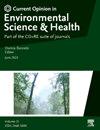用于检测和监测废水中污染物的传感器
IF 6.6
Q1 ENVIRONMENTAL SCIENCES
Current Opinion in Environmental Science and Health
Pub Date : 2025-03-08
DOI:10.1016/j.coesh.2025.100609
引用次数: 0
摘要
含有有害物质的废水污染对环境和公众健康构成严重威胁,因此必须对废水进行全面监测。因此,传感器已成为识别和测量废水中污染物的重要工具。传感器有不同的类型:化学、电化学(镍基材料、固定六氰高铁酸银纳米颗粒的碳电极)、光学(纤维素膜传感器、光学荧光)和生物传感器(乙酰胆碱酯酶、脲酶)。与传统的电化学、光学和生物传感器相比,实时监测更易于运输,坚固耐用,价格合理,电池寿命更长。由于传感器技术和分析的发展,由于涉及人工智能和物联网的实时系统的参与,废水监测的未来将变得更加敏感、智能、高效和有弹性。这些发展有可能进一步提高污染物检测的可靠性和精度,为更安全的环境程序和成功的公共健康保护开辟道路。本文章由计算机程序翻译,如有差异,请以英文原文为准。

Sensors for detection and monitoring of contaminants in wastewater
Wastewater contamination with hazardous materials poses a serious risk to the environment and public health and hence wastewater must be comprehensively monitored. Therefore, sensors have become essential instruments for identifying and measuring contaminants in wastewater. Sensors are of different types: chemical, electrochemical (nickel-based materials, carbon electrode with immobilized silver hexacyanoferrate nanoparticles), optical (cellulose membrane-based sensors, optical fluorescents), and biosensors (acetylcholinesterase, urease). Compared to the conventional electrochemical, optical and biosensors, real-time monitoring is more readily transportable, robust, affordable, and has a longer battery life. The future of wastewater monitoring is becoming more sensitive, smart, efficient, and resilient due to developments in sensor technologies and analytics, due to the involvement of real-time systems involving artificial intelligence and the Internet of Things. These developments have the potential to improve the reliability and precision of contaminants detection even further, creating the path to more secure environmental procedures and successful public health protection.
求助全文
通过发布文献求助,成功后即可免费获取论文全文。
去求助
来源期刊

Current Opinion in Environmental Science and Health
Medicine-Public Health, Environmental and Occupational Health
CiteScore
14.90
自引率
0.00%
发文量
92
审稿时长
114 days
 求助内容:
求助内容: 应助结果提醒方式:
应助结果提醒方式:


